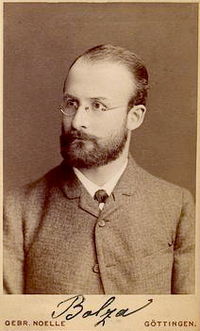- Oskar Bolza
-
Oskar Bolza 
Oskar Bolza (1857-1942)Born 12 May 1857
Bad Bergzabern, Rhenish PalatinateDied 5 July 1942 (aged 85)
Freiburg im Breisgau, GermanyResidence Germany Nationality German Fields Mathematician Institutions University of Chicago
Clark UniversityAlma mater University of Gottingen
University of BerlinDoctoral advisor Felix Klein Doctoral students John Irwin Hutchinson Known for The Bolza problem[1]
Bolza surfaceOskar Bolza (12 May 1857–5 July 1942) was a German mathematician, and student of Felix Klein. He was born in Bad Bergzabern, Rhenish Palatinate, and his parents were Luise Koenig and Moritz Bolza.
He completed his doctoral studies, after eight years of study and many changes of direction, in 1886, from the Georg-August-Universität Göttingen. His thesis was Über die Reduction hyperelliptischer Integrale erster Ordnung und erster Gattung auf elliptische, insbesondere über die Reduction durch eine Transformation vierten Grades (translated as On reduction of hyperelliptic integrals of first order and first kind to elliptic integrals, especially on reduction by transformation of fourth degree[2]) under the supervision of Felix Klein.
In 1889 Bolza worked at Johns Hopkins University, where Simon Newcomb gave him a temporary short-term appointment, then he obtained a position at Clark University. While at Clark, Bolza published the important paper On the theory of substitution groups and its application to algebraic equations in the American Journal of Mathematics.
Bolza joined the University of Chicago in 1892. Between 1892 and 1910 the mathematics department was outstandingly successful with thirty-nine students graduating with doctorates (nine of them students of Bolza). These included Leonard Dickson, who was the first to be awarded a Ph.D. in mathematics by the University of Chicago, Gilbert Bliss, Oswald Veblen, Robert Lee Moore, George D. Birkhoff, and T. H. Hildebrandt.
Bolza published The elliptic s-functions considered as a special case of the hyperelliptic s-functions in 1900 which related to work he had been studying for his doctorate under Klein. However, he worked on the calculus of variations from 1901. Papers which appeared in the Transactions of the American Mathematical Society over the next few years were: New proof of a theorem of Osgood's in the calculus of variations (1901); Proof of the sufficiency of Jacobi's condition for a permanent sign of the second variation in the so-called isoperimetric problems (1902); Weierstrass' theorem and Kneser's theorem on transversals for the most general case of an extremum of a simple definite integral (1906); and Existence proof for a field of extremals tangent to a given curve (1907). His text Lectures on the Calculus of Variations published by the University of Chicago Press in 1904,[3] became a classic in its field and was republished in 1961 and 2005.[4] After the death of his friend Maschke in 1908, Bolza became unhappy in the United States and, in 1910, he and his wife returned to Freiburg in Germany where he was appointed as an honorary professor. Chicago gave him the title of 'non-resident professor of mathematics' which he retained for the rest of his life.
Immediately after his return to Germany Bolza continued teaching and research, in particular on function theory, integral equations and the calculus of variations. Two papers of 1913 and 1914 are particularly important. The first Problem mit gemischten Bedingungen und variablen Endpunkten formulated a new type of variational problem now called 'the problem of Bolza' and the second studied variations for an integral problem involving inequalities. This latter work was to become important in control theory. Bolza returned to Chicago for part of 1913 giving lecturers during the summer on function theory and integral equations.
World War I greatly affected Bolza and, after 1914, he undertook no further research in mathematics. He became interested in religious psychology, languages (particularly Sanskrit), and Indian religions. He published Glaubenlose Religion (religion without belief) in 1930 under the pseudonym F. H. Marneck. He returned to mathematics, however, lecturing at University of Freiburg from 1929 to 1933, when he retired.
Contents
Notes
- ^ Bolza Problem -- from Wolfram MathWorld at mathworld.wolfram.com
- ^ gdz.sub.uni-goettingen.de
- ^ Available on Digital Mathematics Library
- ^ Bolza, Oskar (2005). Lectures On The Calculus of Variations. Scholarly Publishing Office, University of Michigan Library. ISBN 978-1418182014.
See also
References
- Bliss, GA (1943). "OSKAR BOLZA.". Science 97 (2509): pp. 108–109. 1943 Jan 29. doi:10.1126/science.97.2509.108. PMID 17758494
External links
Categories:- 1857 births
- 1942 deaths
- People from Bad Bergzabern
- German mathematicians
- 19th-century mathematicians
- 20th-century mathematicians
- Geometers
- University of Chicago faculty
Wikimedia Foundation. 2010.
